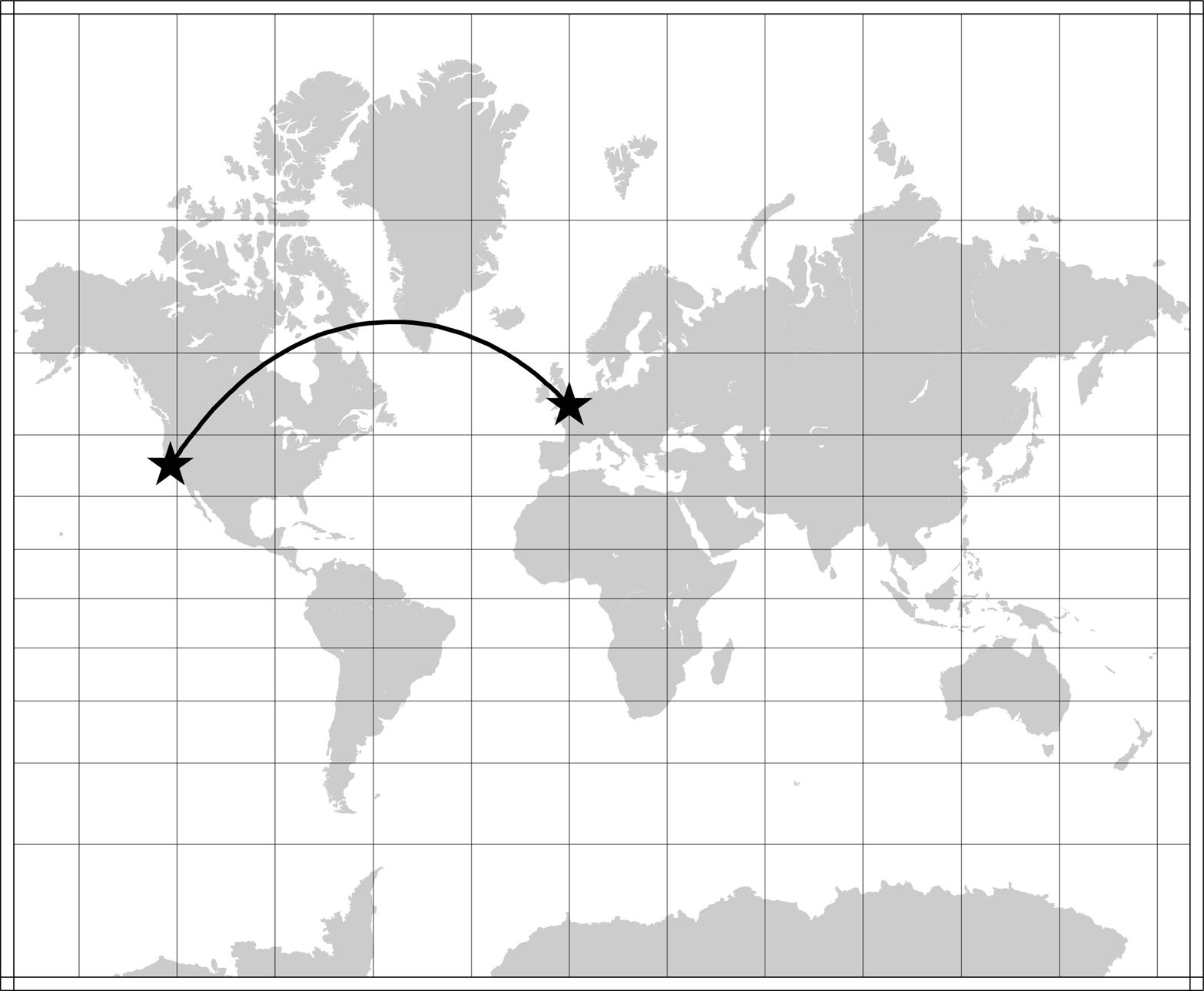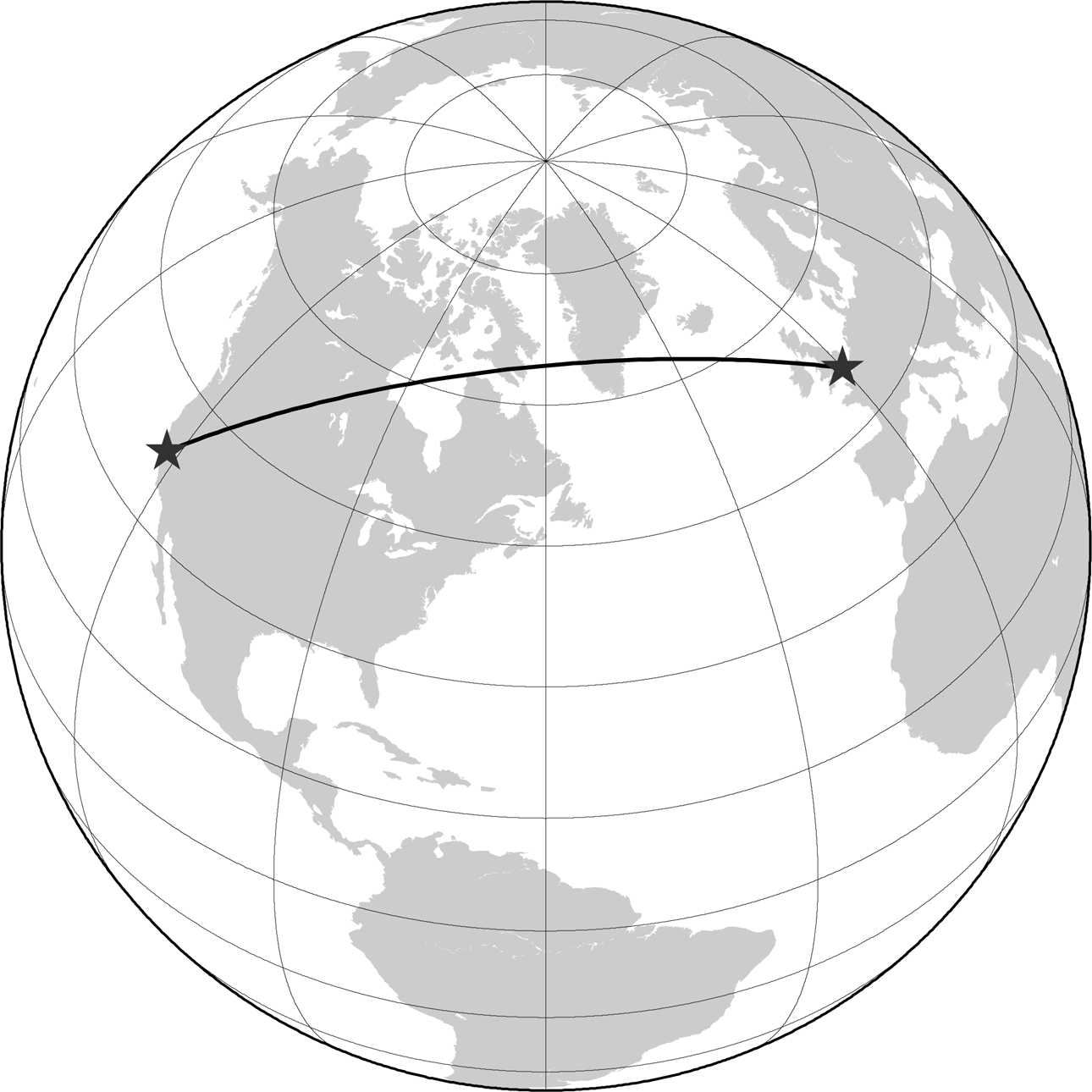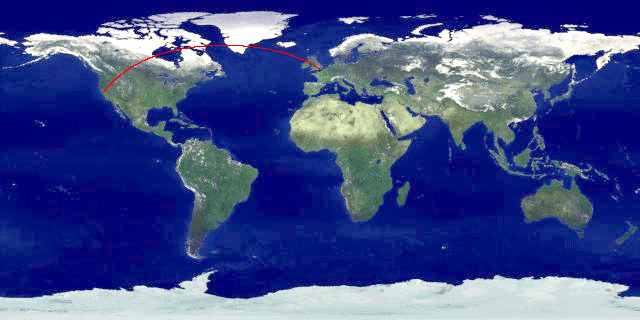Hack 30. Plot a Great Circle on a Flat Map


Wherein our heroes discover that the shortest distance between two points on a globe is not a straight line, after all.
What's so great about a great circle? A great circle, technically speaking, is any circle that goes all the way around a sphere, with its center on the exact center point of the sphere. As it turns out, when a great circle connects two points on a sphere, the arc between them is always the shortest distance between those two points. Naturally, being able to take the shortest possible path is a matter of great financial and practical importance in this modern era of air travel.
Familiar two-dimensional map projections don't give a good impression of great-circle distance. On a Mercator map, the straight line that seems to be the shortest route between San Francisco and London passes through Boston; but, in fact, due to the curvature of the globe, the actual shortest route runs nearer to the North Pole, passing over the south of Greenland.
This hack makes use of Generic Mapping Tools, or GMT [Hack #28] to show how to plot segments of a great circle on many different cartographic projections, including those designed for marine and aerial navigation. We'll also show you how you can try this yourself with a quick Perl script.
3.10.1. Great Circles on a Mercator Projection
The Mercator projection was historically useful because it preserved navigational direction along lines of constant bearing, known as rhumb lines. One could draw a straight line to one's destination on the map, set off in the direction indicated by that line, and actually arrive at the intended destination sometime in the future. Navigating by a Mercator map therefore had the great advantage of simplicity, but the disadvantage was that the rhumb line between two points was often not the shortest path.
Instead, the shortest path between two points follows a line of variable bearing, which turns out to be the arc of a great circle. This may seem counterintuitive, because a great-circle arc will usually end up looking curved on a flat map. Figure 3-31 depicts the great-circle arc connecting San Francisco and London on a Mercator projection of the world.
Figure 3-31. Great-circle arc from SF to London on a Mercator projection

The following commands, using pscoast and psxy from GMT, were used to generate Figure 3-31:
$ pscoast -JM18c -R-170/190/-75/85 -Bg30/g15 -A5000 -G192/192/192 -K > mercator.ps $ psxy points.txt -JM18c -R-170/190/-75/85 -W8 -O -K >> mercator.ps $ psxy points.txt -JM18c -R-170/190/-75/85 -Sa.75c -G0/0/0 -O >> mercator.ps
The call to pscoast draws the graticule (i.e., grid lines) and the base map of the continents. We recommend reviewing [Hack #28] to understand exactly how these particular pscoast options do their magic. The first call to psxy actually draws the great-circle arc into the same file. We give psxy the same projection parameters we did pscoast, along with a filename, points.txt. The points.txt file simply contains the following:
-122,38 0,51
The geographically savvy reader will recognize these as the longitude and latitude coordinates of San Francisco and London, respectively. The -W8 option to psxy tells it to make the great-circle arc 8 pixels thick. Finally, we call psxy one more time, with the same projection parameters and filename containing our points, but this time we give the -S option to request that symbols be drawn at each point, instead of a line connecting them. In this case, the -Sa.75c option draws us a star .75 centimeters wide at each end point, coloring each one black via the -G option.
|
3.10.2. Great Circles on an Orthographic Projection
The fact that a great circle forms the shortest line between two points doesn't seem quite as odd, however, when you look at a globe. Figure 3-32 depicts the same great-circle arc connecting San Francisco and London on an orthographic projection, which presents a flat perspective view of a globe. From this vantage, it becomes evident that the shortest route from San Francisco to London really does sort of run over the curve of the earth, as it were, rather than around it. Consequently, the line that runs between them through Bostonthe line one might have thought was the shortest, looking at a Mercator mapis actually quite hopelessly roundabout.
Figure 3-32. Great-circle arc from San Francisco to London on an orthographic projection

Figure 3-32 was made using the same GMT commands as Figure 3-31, except that the -JM18c parameter for generating a Mercator projection was replaced with -JG-60/45/18c, which draws an orthographic projection 18 centimeters wide, centered on 60º W and 45º N.
3.10.3. Great Circles on a Gnomonic Projection
There are other ways to visualize great circles on a flat map, of course. If we want a map that depicts the shortest distance between two points as a straight line, we can turn to the Gnomonic projection. Basically, any straight line on a Gnomonic projection, regardless of origin or bearing, represents a great-circle arc on Earth's surface. Although the Gnomonic projection distorts the shape and area of landmasses something fierce, the property of showing any great-circle arc as a straight line makes it quite useful for the purposes of air navigation. Figure 3-33 shows the great circle connecting London and San Francisco on a Gnomonic projection of the world. Figure 3-33 was generated with GMT in the same fashion as Figures 3-31 and 3-32, using the -JF-75/60/60/18c option to plot the Gnomonic projection centered on 75º W and 60º N, with a radius of 60º.
Figure 3-33. Great-circle arc from San Francisco to London on a Gnomonic projection

3.10.4. Great Circles of Perl
In practice, great-circle routes are hard to navigate precisely, because the bearing of a great circle relative to True North changes continually, unlike that of a rhumb line. In fact, the conventional way to navigate a great-circle route is to approximate it with a series of short rhumb lines. We can use this same technique to draw the path of a great-circle arc on a flat map in Perl:
#!/usr/bin/perl
use Math::Trig qw(great_circle_direction deg2rad);
use Imager;
use strict;
my ($mapfile, $lon1, $lat1, $lon2, $lat2) = @ARGV;
my @origin = ($lon1, $lat1);
my @dest = ($lon2, $lat2);
my $step = .1;
my @position = @origin;
my @points;
until (abs($position[0] - $dest[0]) < $step
and abs($position[1] - $dest[1]) < $step) {
my $bearing = great_circle_direction(
deg2rad( $position[0] ),
deg2rad( 90 - $position[1] ),
deg2rad( $dest[0] ),
deg2rad( 90 - $dest[1] )
);
$position[0] += sin($bearing) * $step / cos(deg2rad($position[1])) ;
$position[1] += cos($bearing) * $step;
$position[0] += 360 if $position[0] < -180;
$position[0] -= 360 if $position[0] > 180;
push @points, @position;
}
In the first part of our script, we do the actual approximation of rhumb lines to a great circle, using the great_circle_direction() function from the Math::Trig module, which ships with Perl. We get the name of an image containing an Equidistant Cylindrical projection, as well as the longitude and latitude of our start and end points from the command line. We set @origin to the longitude and latitude of our starting point, and @dest to that of our destination. $step is chosen to roughly approximate the length of each component rhumb line. The current position is stored in @position, which gets initialized to our origin.
At each step, we call great_circle_direction() to find the bearing from True North at our current position along the great circle to our destination. Since great_circle_direction() expects its arguments in radians, not degrees, and places the zero latitude at the North Pole, rather than the equator, we have to make the proper adjustments before passing those values. We store the result in radians in $bearing, which we then use to update our current position.
Updating the latitude of our current position, as stored in $position[1], is easy: simply add the cosine of our bearing scaled by the length of our rhumb line to find the latitude of our next end point. If you dig deep into the mists of your high school trigonometry education, you'll remember why this is so: If we take $step to be the length of the hypotenuse of a right triangle, then the cosine of the bearing is equal to the length of the adjacent side divided by the length of the hypotenuse.
Multiplying both sides of the equation by $step yields the code shown earlier for updating $position[1].
Updating the longitude, however is a little trickier. We could simply take our current longitude, stored in $position[0], and add the sine of our current bearing, scaled by the length of our rhumb line, but we would be ignoring an important fact about our round world. As you head toward the poles, the distance between two lines of longitude gets shorter in proportion to the cosine of the latitude. At the equator, the distance separating one degree of longitude is cos(0º) = 1 degree of latitude. At the North Pole, the distance is cos(90º), which is zero. Thus we divide our longitude increment by the cosine of the current latitude, in order to keep in step with the actual great- circle arc.
|
Finally, we do some bounds checking, to keep our longitude from running off the edge of the map. Having done so, we add our new current position to @points, and repeat, until we're close enough to our destination that it's not worth continuing.
Now that we have a list of longitude/latitude coordinates in @points, representing the end points of the rhumb line segments that approximate our great-circle arc, we can use any suitable method to plot them on a flat map. For simplicity's sake, we'll use the method outlined in [Hack #29] to draw the great-circle arc between San Francisco and London on an Equidistant Cylindrical map of the world. The remainder of our script, then, reads as follows:
my ($top, $left) = ( 90, -180 );
my ($bottom, $right) = ( -90, 180 );
my $map = Imager->new;
$map->open( file => $mapfile ) or die $map->errstr;
my $x_scale = $map->getwidth / ($right - $left);
my $y_scale = $map->getheight / ($bottom - $top);
while (@points) {
my (@x, @y);
while (my ($lon, $lat) = splice @points, 0, 2) {
push @x, ($lon - $left) * $x_scale;
push @y, ($lat - $top) * $y_scale;
last if @points and $lon < -170 and $points[0] > -170;
}
$map->polyline( x => @x, y => @y, color => "red" );
}
$map->write( fh => *STDOUT, type => "jpeg" ) or die $map->
errstr;
Since this method of plotting points on a rectangular map [Hack #29] is explained elsewhere, we'll gloss over the details here. We load the map image stored earlier in $mapfile into an object stored in $map. The crucial bit happens in the while() loop, where we shift coordinate pairs off of @points, and convert the longitude and latitude to x- and y-coordinates on the map image. Once we've done this, we send our lists of x and y end points to $map->polyline(), to draw the actual arc on the map. We have to be sure to test for the case where the arc crosses the international date line, and break the polyline into two parts, if necessary. The last if @points... statement tests for this possibility. Finally, the map is dumped to standard output. The code to run is as follows:
$ perl greatcircle.pl PathfinderMap.jpg -122 38 0 51 > sf_to_london.jpg
We give the script the name of our Equidistant Cylindrical map file [Hack #29] for good sources of such maps), as well as the longitude and latitude of San Francisco and London, in that order. The map, which is shown in Figure 3-34, shows the great-circle arc connecting them. Adding embellishments, such as a marker at each end, is left as an exercise for the reader.
Figure 3-34. Great-circle arc from SF to London, plotted with Perl, on a Equidistant Cylindrical projection

Of course, having found the shortest route from San Francisco to London, you will probably immediately want to know how long that route is, which is a question tackled in [Hack #27] .
3.10.5. See Also
- [Hack #28]
- [Hack #29]
- [Hack #27]
Mapping Your Life
- Hacks 1-13
- Hack 1. Put a Map on It: Mapping Arbitrary Locations with Online Services
- Hack 2. Route Planning Online
- Hack 3. Map the Places Youve Visited
- Hack 4. Find Your House on an Aerial Photograph
- Hack 5. The Road Less Traveled by in MapQuest
- Hack 6. Make Route Maps Easier to Read
- Hack 7. Will the Kids Barf?
- Hack 8. Publish Maps of Your Photos on the Web
- Hack 9. Track the Friendly Skies with Sherlock
- Hack 10. Georeference Digital Photos
- Hack 11. How Far? How Fast? Geo-Enabling Your Spreadsheet
- Hack 12. Create a Distance Grid in Excel
- Hack 13. Add Maps to Excel Spreadsheets with MapPoint
Mapping Your Neighborhood
- Hacks 14-21
- Hack 14. Make Free Maps of the United States Online
- Hack 15. Zoom Right In on Your Neighborhood
- Hack 16. Who Are the Neighbors Voting For?
- Hack 17. Map Nearby Wi-Fi Hotspots
- Hack 18. Why You Cant Watch Broadcast TV
- Hack 19. Analyze Elevation Profiles for Wireless Community Networks
- Hack 20. Make 3-D Raytraced Terrain Models
- Hack 21. Map Health Code Violations with RDFMapper
Mapping Your World
- Hacks 22-34
- Hack 22. Digging to China
- Hack 23. Explore David Rumseys Historical Maps
- Hack 24. Explore a 3-D Model of the Entire World
- Hack 25. Work with Multiple Lat/Long Formats
- Hack 26. Work with Different Coordinate Systems
- Hack 27. Calculate the Distance Between Points on the Earths Surface
- Hack 28. Experiment with Different Cartographic Projections
- Hack 29. Plot Arbitrary Points on a World Map
- Hack 30. Plot a Great Circle on a Flat Map
- Hack 31. Plot Dymaxion Maps in Perl
- Hack 32. Hack on Base Maps in Your Favorite Image Editor
- Hack 33. Georeference an Arbitrary Tourist Map
- Hack 34. Map Other Planets
Mapping (on) the Web
- Hacks 35-46
- Hack 35. Search Local, Find Global
- Hack 36. Shorten Online Map URLs
- Hack 37. Tweak the Look and Feel of Web Maps
- Hack 38. Add Location to Weblogs and RSS Feeds
- Hack 39. View Your Photo Thumbnails on a Flash Map
- Hack 40. Plot Points on a Spinning Globe Applet
- Hack 41. Plot Points on an Interactive Map Using DHTML
- Hack 42. Map Your Tracklogs on the Web
- Hack 43. Map Earthquakes in (Nearly) Real Time
- Hack 44. Plot Statistics Against Shapes
- Hack 45. Extract a Spatial Model from Wikipedia
- Hack 46. Map Global Weather Conditions
Mapping with Gadgets
- Hacks 47-63
- How GPS Works
- Hack 47. Get Maps on Your Mobile Phone
- Hack 48. Accessorize Your GPS
- Hack 49. Get Your Tracklogs in Windows or Linux
- Hack 50. The Serial Port to USB Conundrum
- Hack 51. Speak in Geotongues: GPSBabel to the Rescue
- Hack 52. Show Your Waypoints on Aerial Photos with Terrabrowser
- Hack 53. Visualize Your Tracks in Three Dimensions
- Hack 54. Create Your Own Maps for a Garmin GPS
- Hack 55. Use Your Track Memory as a GPS Base Map
- Hack 56. Animate Your Tracklogs
- Hack 57. Connect to Your GPS from Multiple Applications
- Hack 58. Dont Lose Your Tracklogs!
- Hack 59. Geocode Your Voice Recordings and Other Media
- Hack 60. Improve the Accuracy of Your GPS with Differential GPS
- Hack 61. Build a Map of Local GSM Cells
- Hack 62. Build a Car Computer
- Hack 63. Build Your Own Car Navigation System with GpsDrive
Mapping on Your Desktop
- Hacks 64-77
- Hack 64. Mapping Local Areas of Interest with Quantum GIS
- Hack 65. Extract Data from Maps with Manifold
- Hack 66. Java-Based Desktop Mapping with Openmap
- Hack 67. Seamless Data Download from the USGS
- Hack 68. Convert Geospatial Data Between Different Formats
- Hack 69. Find Your Way Around GRASS
- Hack 70. Import Your GPS Waypoints and Tracklogs into GRASS
- Hack 71. Turn Your Tracklogs into ESRI Shapefiles
- Hack 72. Add Relief to Your Topographic Maps
- Hack 73. Make Your Own Contour Maps
- Hack 74. Plot Wireless Network Viewsheds with GRASS
- Hack 75. Share Your GRASS Maps with the World
- Hack 76. Explore the Effects of Global Warming
- Conclusion
- Hack 77. Become a GRASS Ninja
Names and Places
- Hacks 78-86
- Hack 78. What to Do if Your Government Is Hoarding Geographic Data
- Hack 79. Geocode a U.S. Street Address
- Hack 80. Automatically Geocode U.S. Addresses
- Hack 81. Clean Up U.S. Addresses
- Hack 82. Find Nearby Things Using U.S. ZIP Codes
- Hack 83. Map Numerical Data the Easy Way
- Hack 84. Build a Free World Gazetteer
- Hack 85. Geocode U.S. Locations with the GNIS
- Hack 86. Track a Package Across the U.S.
Building the Geospatial Web
- Hacks 87-92
- Hack 87. Build a Spatially Indexed Data Store
- Hack 88. Load Your Waypoints into a Spatial Database
- Hack 89. Publish Your Geodata to the Web with GeoServer
- Hack 90. Crawl the Geospatial Web with RedSpider
- Hack 91. Build Interactive Web-Based Map Applications
- Hack 92. Map Wardriving (and other!) Data with MapServer
Mapping with Other People
- Hacks 93-100
- Hack 93. Node Runner
- Hack 94. Geo-Warchalking with 2-D Barcodes
- Hack 95. Model Interactive Spaces
- Hack 96. Share Geo-Photos on the Web
- Hack 97. Set Up an OpenGuide for Your Hometown
- Hack 98. Give Your Great-Great-Grandfather a GPS
- Hack 99. Map Your Friend-of-a-Friend Network
- Hack 100. Map Imaginary Places
EAN: 2147483647
Pages: 172

